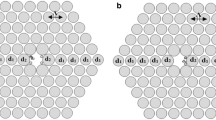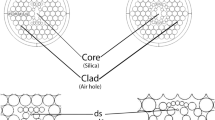Abstract
In this paper, a new structure of highly nonlinear low dispersion photonic crystal fiber (HNPCF) by elliptical concentration of GeO2 in the PCF core has been proposed. Using finite difference time domain (FDTD) method, we have analyzed the dispersion properties and effective mode area in the HN-PCF. Simulative results show that the dispersion variation is within ±0.65 ps/(nm·km) in C-band, especially 0.24 ps/(nm·km) in 1.55 μm wavelength. Effective area and nonlinear coefficient are 1.764 μm2 and 72.6W−1·km−1 respectively at 1.55 μm wavelength. The proposed PCF demonstrates high nonlinear coefficient, ultra small effective mode area and nearly-zero flattened dispersion characteristics over Cband, which can have important application in all-optical wavelength conversion based on four wave mixing (FWM).
Similar content being viewed by others
References
Geraghty D F, Lee R B, Verdiell M, Ziari M, Mathur A, Vahala K J. Wavelength conversion for WDM communication systems using four-wave mixing in semiconductor optical amplifiers. IEEE Journal on Selected Topics in Quantum Electronics, 1997, 3(5): 1146–1155
Bhuiyan M N, Matsuura M, Nguyen Tan H, Kishi N. Polarization-insensitive and widely tunable wavelength conversion for polarization shift keying signal based on four wave mixing in highly nonlinear fiber. Optics Express, 2010, 18(3): 2467–2476
Qasaimeh O. Theory of four-wave mixing wavelength conversion in quantum dot semiconductor optical amplifiers. IEEE Photonics Technology Letters, 2004, 16(4): 993–995
Brès C S, Zlatanovic S, Wiberg A O J, Radic S. Continuous-wave four-wave mixing in cm-long Chalcogenide microstructured fiber. Optics Express, 2011, 19(26): B621–B627
Ho M C, Marhic M E, Wong K Y K, Kazovsky L G. Narrow-linewidth idler generation in fiber four-wave mixing and parametric amplification by dithering two pumps in opposition of phase. Journal of Lightwave Technology, 2002, 20(3): 469–476
Kanka J. Design of photonic crystal fibers with highly nonlinear glasses for four-wave-mixing based telecom applications. Optics Express, 2008, 16(25): 20395–20408
Cerqueira S A Jr, Boggio J M, Rieznik A A, Hernandez-Figueroa H E, Fragnito H L, Knight J C. Highly efficient generation of broadband cascaded four-wave mixing products. Optics Express, 2008, 16(4): 2816–2828
Zhang A, Demokan MS. Broadband wavelength converter based on four-wave mixing in a highly nonlinear photonic crystal fiber. Optics Letters, 2005, 30(18): 2375–2377
Russell P. Photonic-crystal fibers. Journal of Lightwave Technology, 2006, 24(12): 4729–4749
Saitoh K, Florous N, Koshiba M. Ultra-flattened chromatic dispersion controllability using a defected-core photonic crystal fiber with low confinement losses. Optics Express, 2005, 13(21): 8365–8371
Saitoh K, Koshiba M, Hasegawa T, Sasaoka E. Chromatic dispersion control in photonic crystal fibers: application to ultra-flattened dispersion. Optics Express, 2003, 11(8): 843–852
Chow K K, Kikuchi K, Nagashima T, Hasegawa T, Ohara S, Sugimoto N. Four-wave mixing based widely tunable wavelength conversion using 1-m dispersion-shifted bismuth-oxide photonic crystal fiber. Optics Express, 2007, 15(23): 15418–15423
Wang Z, Liu H, Huang N, Sun Q, Wen J. Efficient terahertz-wave generation via four-wave mixing in silicon membrane waveguides. Optics Express, 2012, 20(8): 8920–8928
Dong L, Thomas B K, Fu L. Highly nonlinear silica suspended core fibers. Optics Express, 2008, 16(21): 16423–16430
Saitoh K, Koshiba M. Highly nonlinear dispersion-flattened photonic crystal fibers for supercontinuum generation in a telecommunication window. Optics Express, 2004, 12(10): 2027–2032
Xu Q, Miao R, Zhang Y. Highly nonlinear low-dispersion photonic crystal fiber with high birefringence for four-wave mixing. Optical Materials, 2012, 35(2): 217–221
Sheng X Z, Lou S Q. Influence of deformation holes on properties of photonic crystal fibers. Chinese Physics Letters, 2005, 22(10): 2588–2591
Saitoh K, Koshiba M. Numerical modeling of photonic crystal fibers. Journal of Lightwave Technology, 2005, 23(11): 3580–3590
Sun T T, Kai G Y, Wang Z, Yuan S Z, Dong X Y. Enhanced nonlinearity in photonic crystal fiber by germanium doping in the core region. Chinese Optics Letters, 2008, 6(2): 93–95
Butov O V, Golant K M, Tomashuk A L, van Stralen M J N, Breuls A H E. Refractive index dispersion of doped silica for fiber optics. Optics Communications, 2002, 213(4–6): 301–308
Nakajima K, Ohashi M. Dopant dependence of effective nonlinear refractive index in GeO2- and F-doped core single-mode fibers. IEEE Photonics Technology Letters, 2002, 14(4): 492–494
Chen M Y, Subbaraman H, Chen R T. One stage pulse compression at 1554 nm through highly anomalous dispersive photonic crystal fiber. Optics Express, 2011, 19(22): 21809–21817
Wang J, Jiang C, Hu W, Gao M. Modified design of photonic crystal fibers with flattened dispersion. Optics & Laser Technology, 2006, 38(3): 169–172
Udagedara I, Premaratne M, Rukhlenko I D, Hattori H T, Agrawal G P. Unified perfectly matched layer for finite-difference time-domain modeling of dispersive optical materials. Optics Express, 2009, 17(23): 21179–21190
Taniyama H, Sumikura H, Notomi M. Finite-difference timedomain analysis of photonic crystal slab cavities with two-level systems. Optics Express, 2011, 19(23): 23067–23077
Lamont M R, Kuhlmey B T, de Sterke C M. Multi-order dispersion engineering for optimal four-wave mixing. Optics Express, 2008, 16(10): 7551–7563
Author information
Authors and Affiliations
Corresponding author
Rights and permissions
About this article
Cite this article
Monfared, Y.E., Mojtahedinia, A., Maleki Javan, A.R. et al. Highly nonlinear enhanced-core photonic crystal fiber with low dispersion for wavelength conversion based on four-wave mixing. Front. Optoelectron. 6, 297–302 (2013). https://doi.org/10.1007/s12200-013-0336-8
Received:
Accepted:
Published:
Issue Date:
DOI: https://doi.org/10.1007/s12200-013-0336-8




